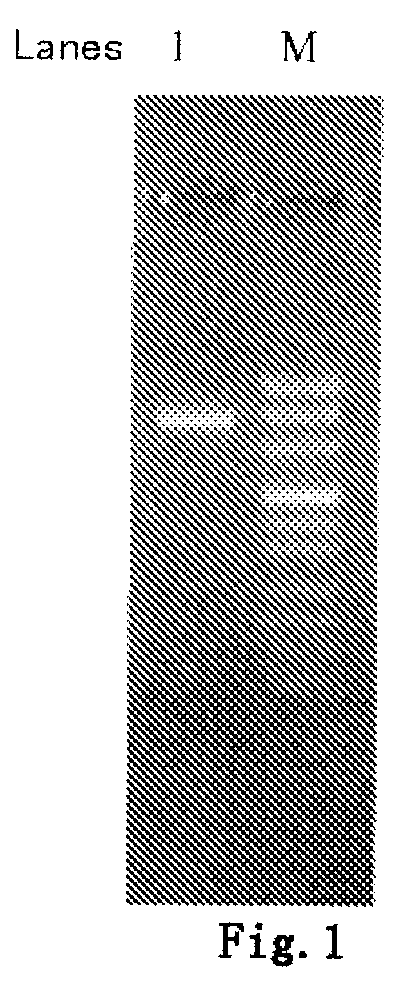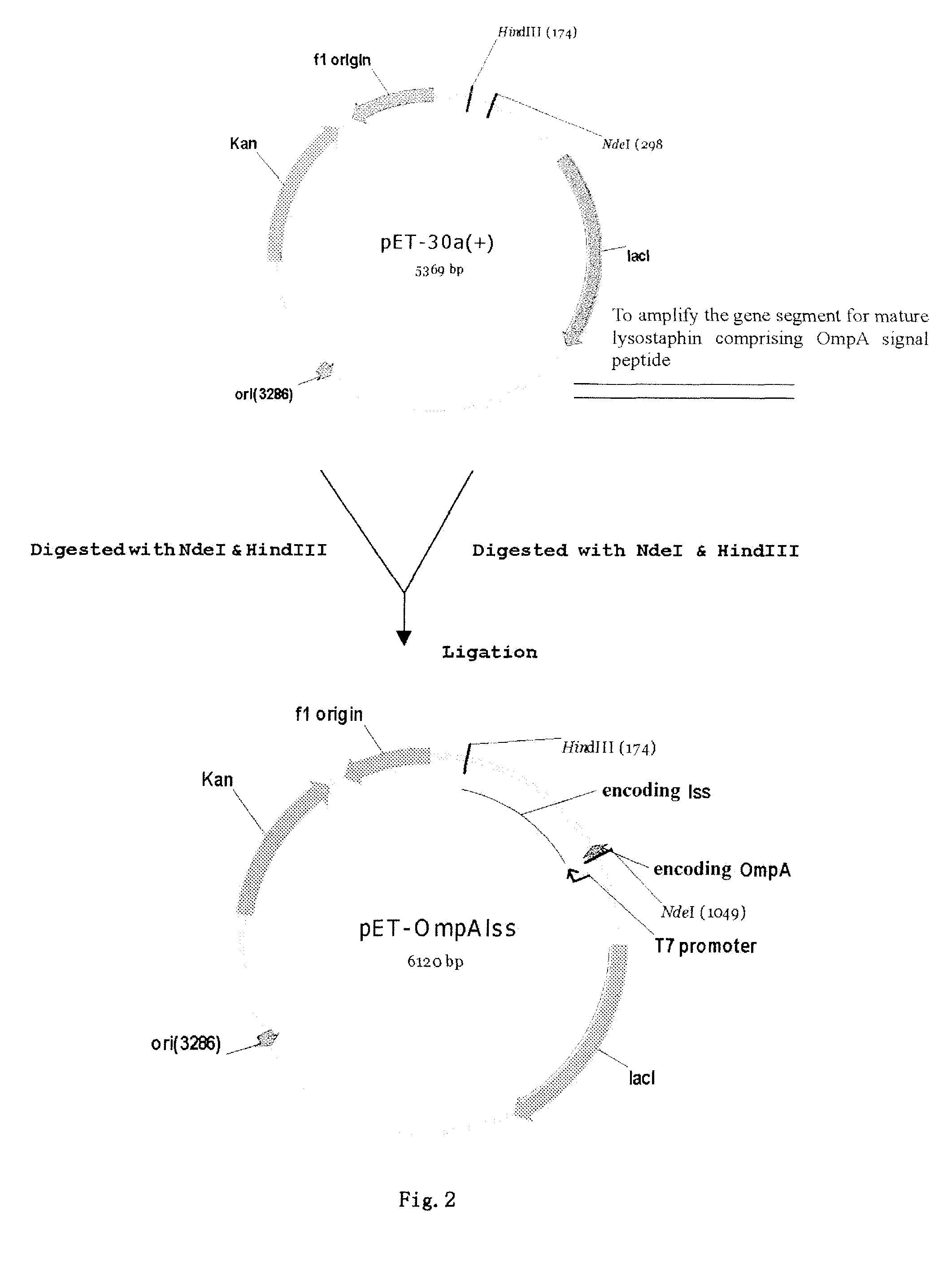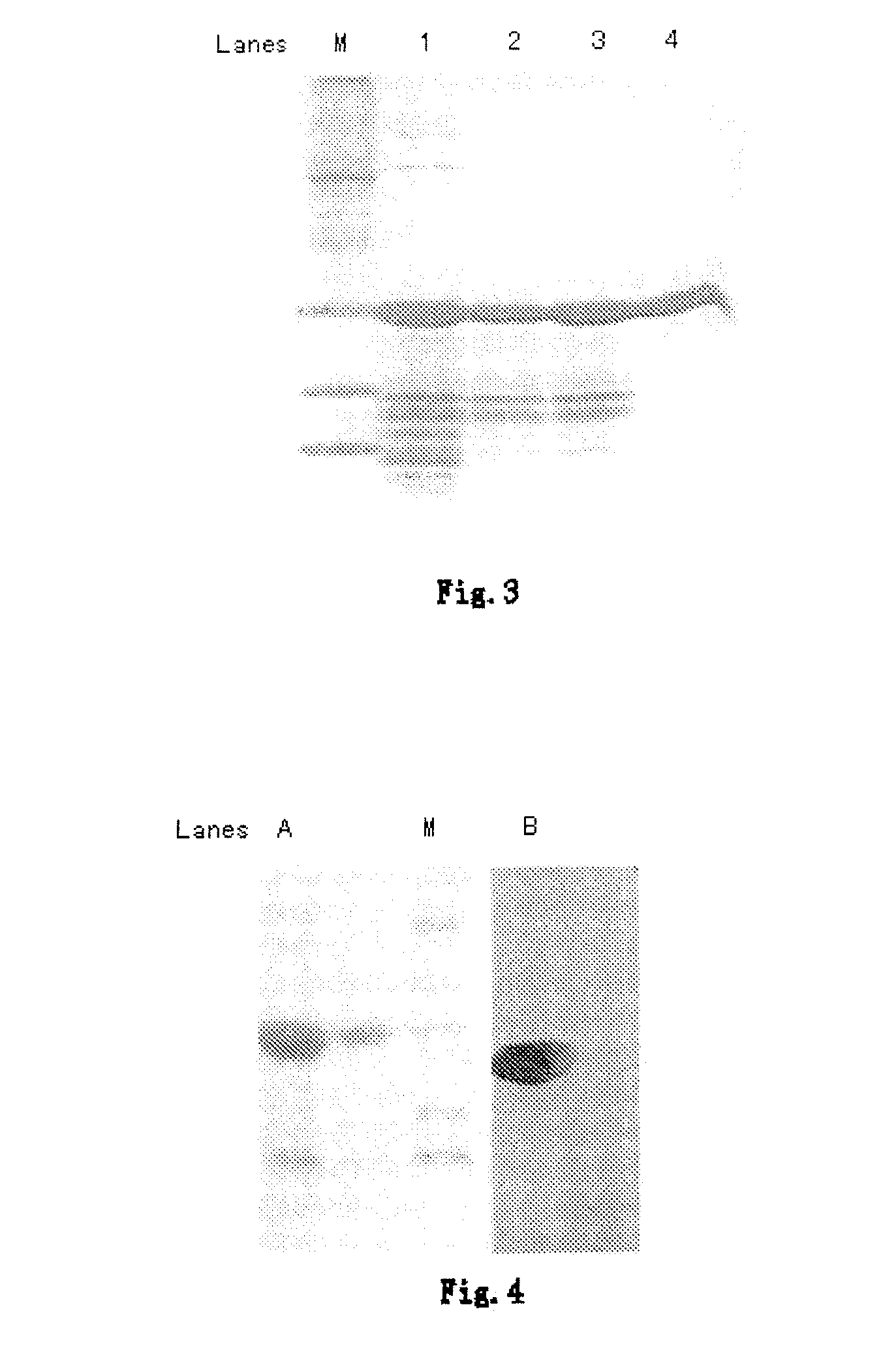Method of secretory expression of lysostaphin in Escherichia coli at high level
a technology of lysostaphin and secretory expression, which is applied in the field of high-level secretory expression of lysostaphin in escherichia coli, can solve the problem of high cost of such an expression, and achieve the effect of less protein contaminants and easy and convenient purification of interested proteins
- Summary
- Abstract
- Description
- Claims
- Application Information
AI Technical Summary
Benefits of technology
Problems solved by technology
Method used
Image
Examples
example 1
Construction of Secretory Expression Vector of Recombinant Lysostaphin, i.e. Cloning of Fusion Gene of the OmpA Signal Peptide and the Mature Lysostaphin
[0054]First, the oligo-nucleotide sequence was designed and synthesized below:
[0055]
SEQ ID NO: 15′-TACATAAAAAGACAGCTATCGCGATTGCAGTGGCACTGGCAGGTTTCGCTACCGTCGCTCAGGCTGCTGCAACACATGAACATTCAGCAC-3′SEQ ID NO: 25′-CCAAAGCTTCAACTTTAGGAATGAG-3′
[0056]In designing SEQ ID NO:1, at 5′ terminus was added with a gene sequence of NdeI restriction enzyme site (italic part), as well as a gene sequence encoding OmpA signal peptide (underlined part).
[0057]In designing SEQ ID NO: 2, at 5′ terminus was added with a gene sequence of HindIII restriction enzyme site (italic part).
[0058]The lysostaphin sequence was selectively amplified through PCR method using pyrobest enzyme (a high fidelity DNA polymerase), and whole DNA of Staphylococus simulans (NRRL B-2628) as a template, and SEQ ID NO: 1 and SEQ ID NO: 2 as a pair of primers. The amplified product was...
example 2
Establishment of Engineered Bacteria Expressing Recombinant Lysostaphin by Means of Secretion
[0065]Escherichia coli strains TOP10, JM109(DE3), BL21(DE3) were transfromed with recombinant plasmid pET-OmpAlss, respectively. Positive clones were picked out and inoculated into 50 ml LB broth (containing 30 mg / ml kanamycin), and incubated at 37 degrees C. with shaking, till OD600 of the cultured broth increased to 0.6, then IPTG was added to a final concentration of 0.05 mM to induce protein expression, further incubated for another 3 hours. The fermentation culture was centrifugated, and the lysostaphin activity in the supernatant was determined by spectrophotometric assay.
example 3
Determining Lysostaphin Activity by Spectrophotometric Assay
[0066]Escherichia coli strains TOP10, JM109(DE3), BL21(DE3) containing recombinant plasmid pET-OmpAlss of Example 2 were used to determine the lysostaphin activity by spectrophotometric assay. In particular, the determining method is below:
[0067]1. Principle
[0068]The quantitative assay of lysostaphin is accomplished by spectrophotometric assay, using the coupled KNR light blue dyed Staphylococcus aureus cell wall peptidoglycan (KNR-PG) as a color resource substrate. According to the amount of small molecules of soluble segment product carrying the KNR dye moiety that is quantitatively released during the enzyme action process, the supernatant is determined calorimetrically to calculate the activity of the enzyme. This method is easy and convenient, with high sensitivity and visualization.
[0069]2. Instruments and Reagents
[0070]2.1 Instruments:
[0071]2.1.1 Ultra violet—visible spectrophotometer or enzyme-labeled instrument;
[00...
PUM
| Property | Measurement | Unit |
|---|---|---|
| concentration | aaaaa | aaaaa |
| molecular weight | aaaaa | aaaaa |
| molecular weight | aaaaa | aaaaa |
Abstract
Description
Claims
Application Information
 Login to View More
Login to View More - R&D
- Intellectual Property
- Life Sciences
- Materials
- Tech Scout
- Unparalleled Data Quality
- Higher Quality Content
- 60% Fewer Hallucinations
Browse by: Latest US Patents, China's latest patents, Technical Efficacy Thesaurus, Application Domain, Technology Topic, Popular Technical Reports.
© 2025 PatSnap. All rights reserved.Legal|Privacy policy|Modern Slavery Act Transparency Statement|Sitemap|About US| Contact US: help@patsnap.com



